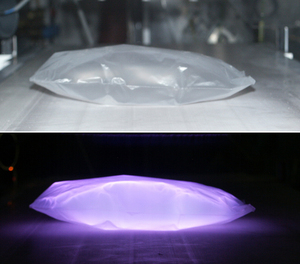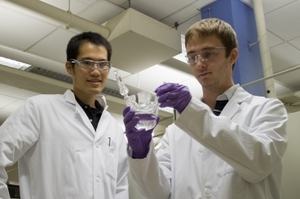| Cell culture bags may replace Petri dishes |
 |
Using plasmas, sealed plastic bags can be modified at atmospheric pressure so that human cells can adhere to and reproduce on their walls. Cell culture bags of this kind are an important aid for research and clinical purposes and may eventually replace the Petri dishes used today. |
| Virtual microscope & lab for the medical student |
 |
For every medical student, examining specimens under the microscope is part of the syllabus. However, the opening hours of the labs and the number of enlargers are limited. Thanks to a new online platform, students are now able to learn with greater flexibility and independence. |
| 3D meso scanner simulates real virtual surface textures |
 |
These days, cars are developed on computers, and to assist with this, designers want processes which generate realistic surfaces such as seat covers. Researchers have now developed high-resolution scanners which copy objects and fabric samples in a few minutes, converting them into virtual models. The light effects are startlingly realistic. |
| Robotic spider for hazardous missions |
 |
Spiders are very agile, and some can even jump. They owe this capability to their hydraulically operated limbs. Researchers have now designed a mobile robot modeled on the same principle that moves spider legs. Created using a 3-D printing process, this lightweight can explore terrain that is beyond human reach. |
| Robotics speeds up glass development |
|
Model by model, the electronics in a car are being moved closer to the engine block. This is why the materials used for the electronics must resist increasing heat – so the glass solder being used as glue must be continually optimized. For the first time ever, a robot takes on the task of developing new types of glass and examining their characteristics. Researchers will introduce this robot at the “productronica“ trade fair to be held in Munich, Germany, from November 15 - 18, 2011 (Hall B2, Booth 135). |
| Modified aluminum alloy breaks down hydrogen for a practical fuel source |
|
A team of researchers from the University of Texas at Dallas and Washington State University in Pullman, WA, has made the counter-intuitive discovery that aluminum, with a minor modification, is able to both break down and capture individual hydrogen atoms, potentially leading to a robust and affordable fuel storage system. |
| Successful Firing of Electromagnetic Railgun |
|
The U.S. Naval Research Laboratory Materials Testing Facility demonstrated, Oct.31, the one-thousandth successful firing of its Electromagnetic Railgun, reaching a materials testing milestone in the weapon's technological development and future implementation aboard U.S. Navy warships. |
| Efficient oxygen catalyst |
 |
New catalyst, made of inexpensive and abundant materials, could prove useful in rechargeable batteries and hydrogen-fuel production. |
| 3D X-rays in the operating room |
 |
Having an operation always places strain on patients, and this is especially true of complicated operations. Surgeons use 3D X-rays to check the results before the patient has left the operating room. This does help to avoid possible complications, but it also means interrupting the surgery. |
Pages: << 17 18 19 [20] 21 22 23 >>
Link to this Webpage:

© Copyright 2000 -
2024, by Engineers Edge, LLC
www.engineersedge.com
All rights reserved
Disclaimer |
Feedback
Advertising
| Contact
|